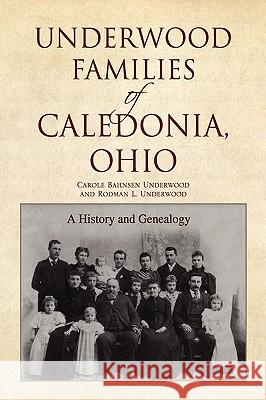Underwood Families of Caledonia, Ohio » książka
Underwood Families of Caledonia, Ohio
ISBN-13: 9781425774868 / Angielski / Twarda / 2007 / 392 str.
Underwood Families Of Caledonia, Ohio consists of many segments that are combined to form synergies that enhance the book. The Underwood account is part family history that includes pertinent biographical data, part genealogy that traces descendants, and part local history that provides information about the development of Caledonia and Ohio. It explores the ancestry and family histories of a specific group of people who migrated westward to a central Ohio hamlet in the eighteenth century and later. Individuals with an Underwood surname first appeared in New England in 1637 after they had sailed across the Atlantic Ocean from Old England. Around the same time, there were other Underwood migrations to the Delaware Bay area, and of principal interest is one group we call the Delaware Family-Caledonia Branch. This family group ultimately spread widely through Pennsylvania, Ohio, and the West. We begin this study with Samuel Underwood who appeared in the Delaware Bay area in the mid-seventeenth century. He is the seminal figure in our examination because beginning with him we have been able to establish a direct line of descendants. This genealogical journey is documented through a total of eight men; we conclude with Miller Harland Underwood (1865-1937) who spent his entire life in or near Caledonia, Ohio. We follow these people as they settle in Pennsylvania before moving westward in their Conestoga wagons to become early pioneers in the Ohio Country. Here they face the perils of disease and hostile Indians and overcome innumerable hardships while migrating into central Ohio. Some of them settle in an area that eventually becomes Caledonia, Ohio. While we focus upon the men composing the direct line, we follow their offspring as well as they spread west to the Pacific Ocean. To accomplish this task, we have organized this book into three parts. The first section consists of pertinent historical data that makes the movement of Underwood families into Ohio more meaningful and places these events within the context of the times. The second portion presents genealogical data, intermixed with family history, in a readable narrative that supports the line of succession of the "Underwood eight" and follows many of their offspring. The last part is an appendix that is a full descendant-ordered National Genealogical Society (NGS) report covering up to 13 generations. It documents more than 2700 individuals, in excess of 800 marriages, and over 600 surnames. Also included is an index of these individuals. We expect our approach to Ohio history and Underwood genealogy will be useful to others as they consider their past and its import for their future. In any event, we trust the reader will find the journey offered by this book to be enjoyable, instructive, and rewarding. Book Excerpt The earliest immigrants to America were from England, but between 1749-1750 more than 30,000 Germans arrived in Pennsylvania. The long voyage across the Atlantic Ocean took two or three months. Gottlieb Mittelberger was a schoolteacher from Germany who, along with 500 of his fellow countrymen, sailed across the Atlantic aboard the Osgood and arrived in Philadelphia in late 1750. He writes of the perils of emigrating from Germany: The people are packed densely, like herrings so to say, in the large sea-vessels. One person receives a place of scarcely 2 feet width and 6 feet length in the bedstead, while many a ship carries four to six hundred souls . . . But during the voyage there is on board these ships terrible misery, stench, fumes, horror, vomiting, many kinds of sea-sickness, fever, dysentery, headache, heat, constipation, boils, scurvy, cancer, mouth rot, and the like, all of which come from old and sharply salted food and meat, also from very bad and foul water, so that many die miserably . . . That most of the people get sick is not surprising because . . . meals can hardly be eaten, on account of being so unclean. The water which is served out of th











